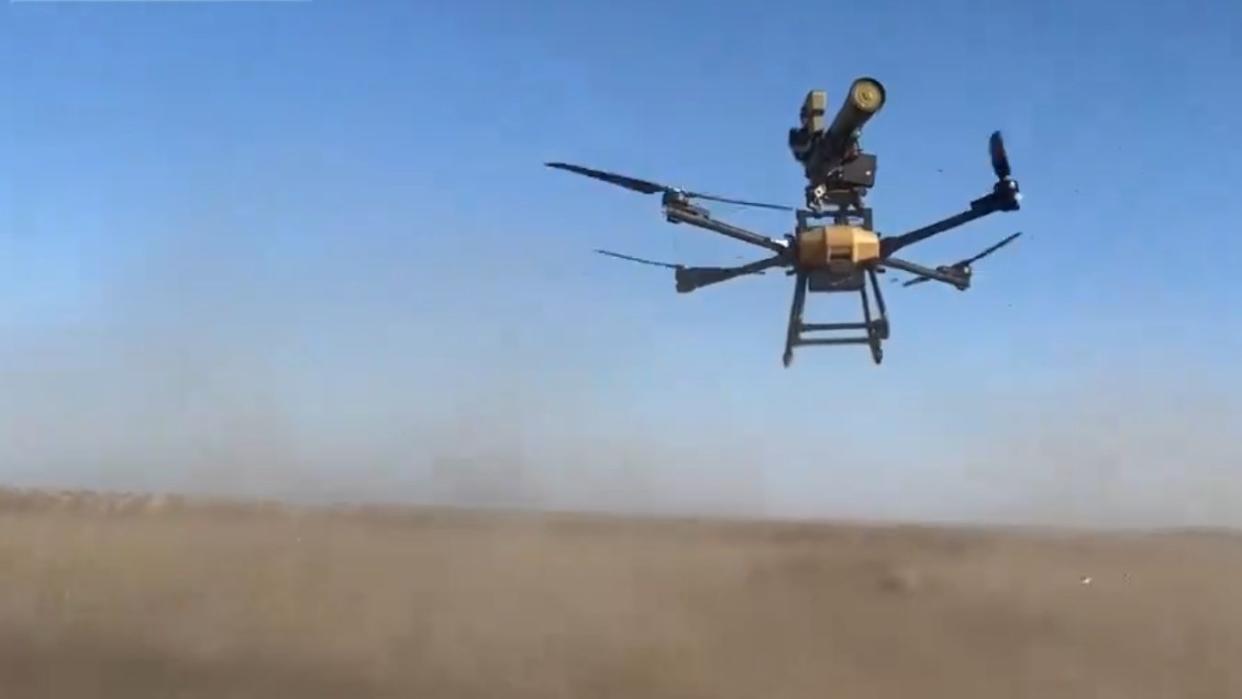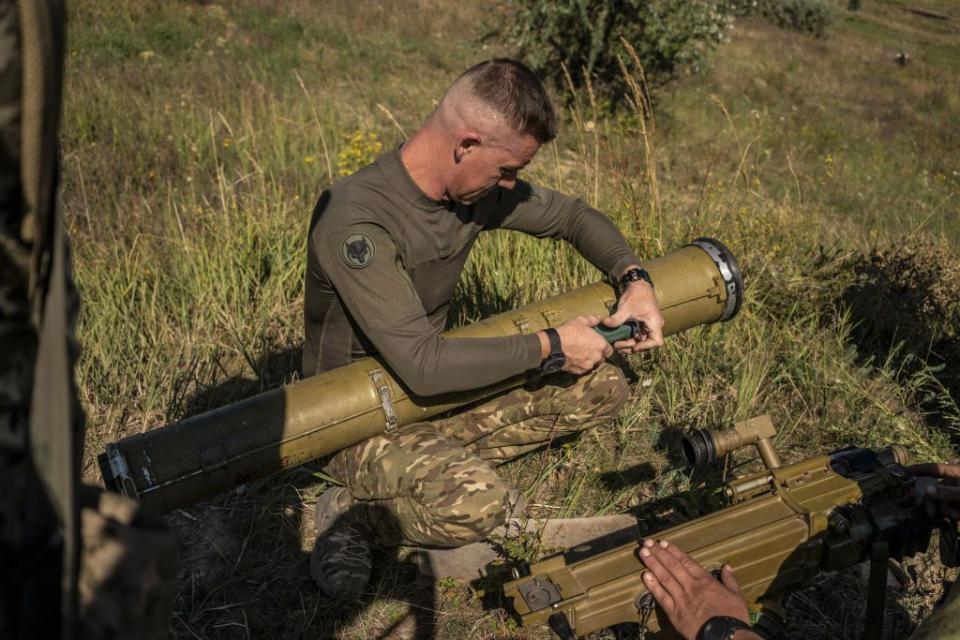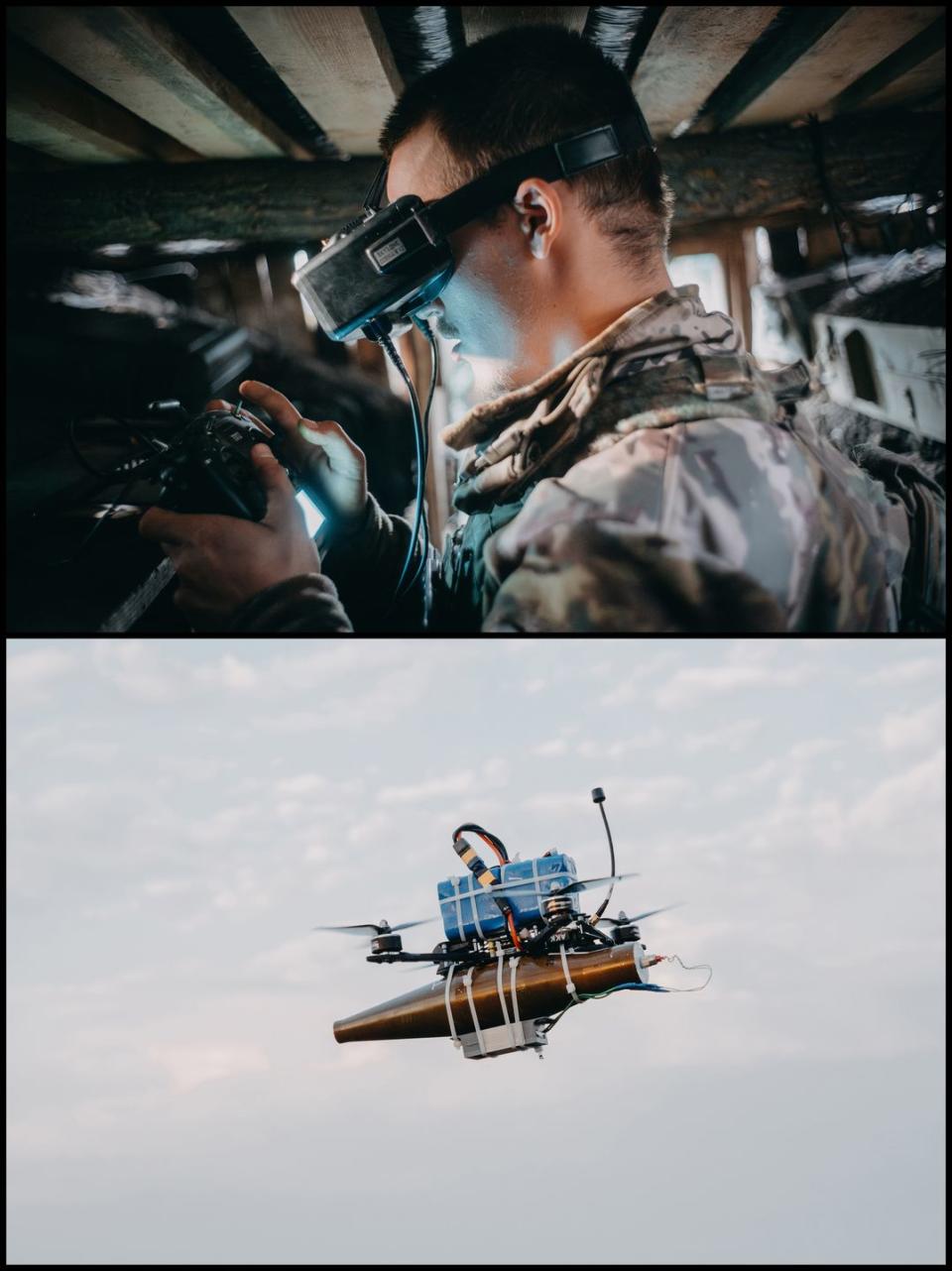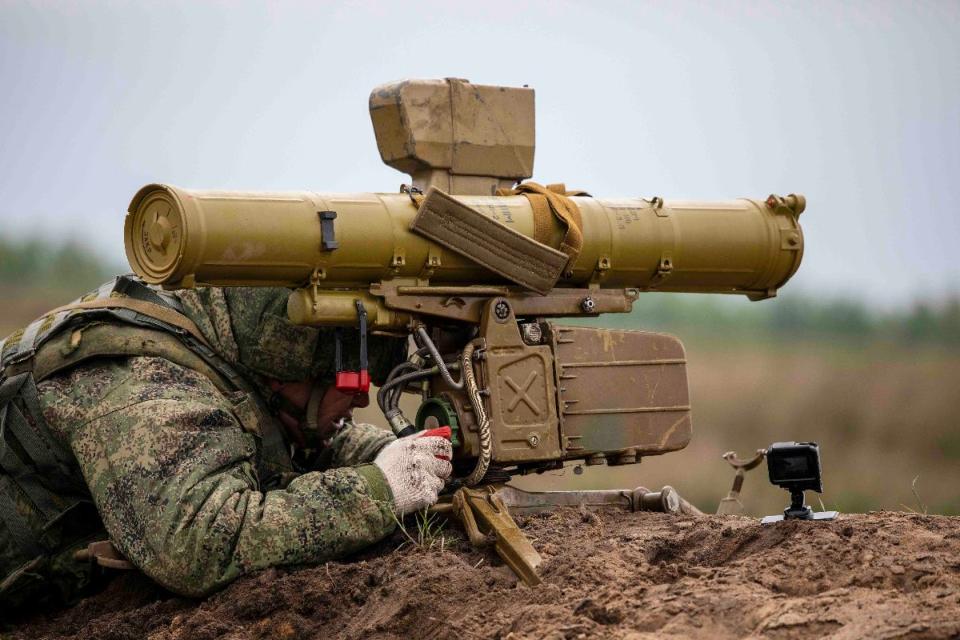Russia Test Launched a Big Anti-Tank Missile From a Civilian Drone

Civilian volunteers on both sides of Russia’s invasion of Ukraine have furiously worked to adapt hundreds of thousands of commercially available drones for combat use by soldiers on the frontline. And along the way, they’ve innovated to deliver more effective weapons—Ukrainians have taken the lead in both fielding drone boats and mass-producing cheap, first-person-view (FPV) kamikaze drones.
Russian volunteers, however, are trying to one-up their rivals by fielding a large anti-tank guided missile—a weapon that many drones would struggle to even lift, and which generates considerable recoil.
The weapon in question is an old 9M111 Fagot (“Bassoon”) wire-guided anti-tank guided missile—also codenamed AT-4 Spigot by NATO—which weighs 28-pounds, including its launch cannister and gas booster.

While the ordinarily 50-pound 9K111 launcher is missing its 9P135 tripod launch post, the 9S451 guidance box is visibly still attached, as is its 10x magnification 9Sh119 sight (which adds substantially more weight). This is a heavier payload than most of the civilian drones used in the war can accommodate.
Russian channels shared a video of the Perun-F UAV equipped with a Fagot ATGM. https://t.co/O1qpQYWcG4https://t.co/cCrtVS3Nlh pic.twitter.com/vcmEC8kXFT
— Rob Lee (@RALee85) January 25, 2024
The volunteers slung the launcher on top of a heavy-duty Perun-F quadcopter drone (not to be confused with a Ukrainian drone of the same name), described as a “heavy assault quadcopter.” According to a Greek drone analyst, it appears to be based on the Chinese EFT Z50 agricultural spraying drone, which can carry up to a 110-pound payload and is currently being sold for prices ranging from $7,000 to $10,000 USD.
The Z50 weighs 100 pounds (including batteries), has the endurance to hover for 7 minutes while carrying a maximum payload and 20 minutes unloaded, and is controlled via a remote control device with a 5.5” screen and range of 1.86 miles.
🎬Z30/Z50 four centrifugal nozzles simultaneous operation guide
Installation tutorial for adding nozzles: https://t.co/NgFnovabzm
Learn more: https://t.co/Xg62dLeFhe#eftdrone #agridrone #sprayingdrone #dronenozzles #largeflow #EFT pic.twitter.com/VhNP6KZadC— EFT Electronic Technology Co. Ltd. (@eft_co) October 11, 2023
The video shows the Perun-F lifting off, achieving a semi-stable hovering state, and firing the powerful 120-millimeter diameter missile—despite the powerful kickback from the gas-generator, which propels the missile from the tube at 180 miles per hour.
The drone is also shown to be capable of firing while landed, which could be useful for setting up an ambush from an unexpected position. This capability likely explains why the missile is mounted atop, not under, the drone.
After launch, the missile’s solid-fuel rocket motor ignites, accelerating the missile to 420 miles per hour—roughly the maximum speed of many a late World War II fighter plane.
There’s a problem, though. The Basoon’s missile is ordinarily semi-automatically guided by a human operator to its target via a spool-out wire that stays connected to the missile throughout its flight. But there’s nobody “on” the drone peering through its sight and physically manipulating its controls. Without such direction, it’s basically just an unguided rocket that’s only likely to hit a very close target.
Drones and anti-tank guided missiles: feasible?
Commercial drones have played an important role in anti-tank warfare in Ukraine. Initially, they were used to gravity-bomb armored vehicles from above with anti-tank grenades, and boasted surprisingly lethal accuracy. While this method is still used on immobilized or abandoned vehicles, by the winter of 2022/2023, it was surpassed by faster, remotely piloted first-person view drones used to ram enemy vehicles while carrying a contact-fused rocket-propelled grenade (RPG) warhead. These could better engage moving targets, and tens of thousands per month could be produced cheaply and quickly.

Anti-tank guided missiles (ATGMs), however, are a different beast than rocket-propelled grenades. RPGs are cheap, highly portable, and have an effective range rarely exceeding a few hundred meters. ATGM systems, on the other hand, weigh dozens of pounds, typically have ranges of 1-4 miles, are more costly, and are guided all the way to target (which may take more than 30 seconds, depending on the weapon and distance.)
So while RPGs are close defense and ambush weapons, ATGMs are rarer, heavy weapons—they’re akin to long-distance snipers that can kill tanks. Furthermore, ATGM-launching helicopters have proven effective. They have superior mobility and vantage to locate and pick off enemy tanks, all while remaining outside the range of many short-range air defenses. So, the Russian ATGM-on-drone project could hypothetically result in a kind of poor man’s anti-tank helicopter.
But without guidance to hit targets at range, ATGMs lose most of their utility compared to RPGs. Furthermore, the 9K111 has a minimum range of 70-75 meters.
The design challenge is to make sure the drone’s operators have a way to both spot the target (preferably from a sight on the drone, parallel to the launcher), and to send guidance commands to the missile midflight in order to keep it on track. Stabilization of the sight used to guide the missile also appears necessary, given the observable wobbliness.
These are solvable problems—though, they are solvable in ways that may cut against either the DIY nature of the project or the drone’s maneuverability. For example, the operators might tether the drone to the missile’s original analog guidance system on the ground (while retaining a videofeed on the drone as a sight). Ukraine’s Stugna-P system, for example, already has a 50-meter cable tether, and such a tether has been improvised for Russian Kornet and 9K111 systems. Of course, that solution would largely remove the system’s mobility.

Or they could expensively devise a remote-control command link for the 1970s-vintage missile, but such bespoke innovations risk exceeding what DIY volunteers can reasonably achieve.
Russia’s newer ATGMs—notably, the larger 9M133 Kornet and lighter 9M131 Metis-M—are laser-beam riding weapons, in which a laser on the launch platform transmits guidance instructions to the missile by reflecting a laser into receivers on the missile’s tail. Those guidance systems might be easier to adapt for remote control, and those weapons also penetrate two or three times the equivalent armor of the original 9M111 model.
It’s noteworthy, though, that the testers used the Bassoon—an over 50-year old weapon—which lacks the penetrating power to reliably defeat the bricks of explosive reactive frontal armor on most Ukrainian tanks. Given the demand for ATGMs on the frontline, perhaps the testers reason that a volunteer-built anti-tank drone will only be able to use older munitions.
A Western-style fire-and-forget missile like Javelin, or one with built in radio data-link like Spike, would simplify the problem—but it isn’t an option for the Russian volunteers.
How anti-tank missile-armed drones could work
A conservative operational concept for drone-launched ATGMs could see these used as stand-ins for the usual ground-based ATGM teams being priority targeted by artillery and armored vehicle cannons. While remaining close to friendly positions, ATGM drones would offer better spotting angles, firing angles, and a degree of mobility—all while sparing human operators from enemy counter-fire (and thus reducing hesitancy to open fire at all).
A more radical concept—reliant on better command-links and jamming resistance, and perhaps AI-assisted target ID and guidance algorithms—might seek to use these drones to infiltrate past the frontline, allowing them to take shots at a tank’s much weaker side and rear armor (which also may make it more likely to achieve surprise). The ability to land these drones and have them lay in wait to spring an ambush from the ground also has interesting tactical potential.
The inherent standoff reach of ATGMs would allow them to both safely strike more distant targets and engage tanks protected by self-defense jammers (which are increasingly common, due to the threat of kamikaze drones). Furthermore, many non-tank assets behind the frontline could be attractive targets, such as command posts, radar systems, supply trucks, communication systems, ammunition depots, and jamming systems.
But before either concept can be implemented, the problem of guidance must be solved.
Samuel Bendett, an expert on Russian unmanned systems and AI at the technology, told Popular Mechanics that he sees the promise of such systems. “That recoil is going to be very powerful, stabilizing this kind of drone can be difficult and and getting an accurate strike can be problematic,” he said. “But if you are looking for a less accurate airborne hit, then this can potentially be appealing.”
Experimental Ukrainian drone with an installed machine gun and ATGM. The drone looks like Agras T-30 pic.twitter.com/VrkWQ4h5wF
— Special Kherson Cat 🐈🇺🇦 (@bayraktar_1love) January 21, 2024
He recalls having observed several previous attempts to mount ATGMs on consumer drones, including from Russia-allied Belarus. Innovators in Ukraine, meanwhile, are known to have test-mounted an anti-tank weapon on a Chinese DJI Agras T-30 hexacopter agricultural spraying drone. Time will tell if such prototypes are iterated into operationally effective platforms.
You Might Also Like

